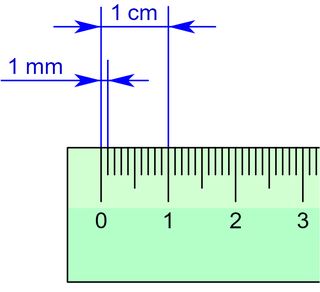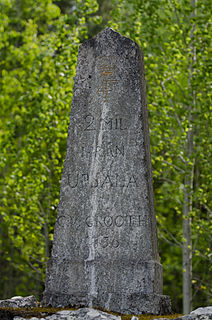Related Research Articles

A minute of arc, arcminute (arcmin), arc minute, or minute arc, denoted by the symbol ′, is a unit of angular measurement equal to 1/60 of one degree. Since one degree is 1/360 of a turn, one minute of arc is 1/21600 of a turn. The nautical mile (nmi) was originally defined as the arc length of a minute of latitude on a spherical Earth, so the actual Earth circumference is very near 21600 nmi. A minute of arc is π/10800 of a radian.

The inch is a unit of length in the British imperial and the United States customary systems of measurement. It is equal to 1/36 yard or 1/12 of a foot. Derived from the Roman uncia ("twelfth"), the word inch is also sometimes used to translate similar units in other measurement systems, usually understood as deriving from the width of the human thumb.

The imperial system of units, imperial system or imperial units is the system of units first defined in the British Weights and Measures Act 1824 and continued to be developed through a series of Weights and Measures Acts and amendments.

The litre or liter is a metric unit of volume. It is equal to 1 cubic decimetre (dm3), 1000 cubic centimetres (cm3) or 0.001 cubic metre (m3). A cubic decimetre occupies a volume of 10 cm × 10 cm × 10 cm and is thus equal to one-thousandth of a cubic metre.

Metrication or metrification is the act or process of converting to the metric system of measurement. All over the world, nations have transitioned from their local and traditional units of measurement to the metric system. This process began in France during the 1790s, and continues more than two centuries later—with the modern SI system—as the metric system has not been fully adopted in all countries and sectors.
The International System of Units, known by the international abbreviation SI in all languages and sometimes pleonastically as the SI system, is the modern form of the metric system and based on the metre as the unit of length and either the kilogram as the unit of mass or the kilogram-force as the unit of force.</ref> and the world's most widely used system of measurement. Established and maintained by the General Conference on Weights and Measures (CGPM), it is the only system of measurement with an official status in nearly every country in the world, employed in science, technology, industry, and everyday commerce.
A metric prefix is a unit prefix that precedes a basic unit of measure to indicate a multiple or submultiple of the unit. All metric prefixes used today are decadic. Each prefix has a unique symbol that is prepended to any unit symbol. The prefix kilo-, for example, may be added to gram to indicate multiplication by one thousand: one kilogram is equal to one thousand grams. The prefix milli-, likewise, may be added to metre to indicate division by one thousand; one millimetre is equal to one thousandth of a metre.

United States customary units form a system of measurement units commonly used in the United States and U.S. territories since being standardized and adopted in 1832. The United States customary system developed from English units which were in use in the British Empire before the U.S. became an independent country. The United Kingdom's system of measures was overhauled in 1824 to create the imperial system, which was officially adopted in 1826, changing the definitions of some of its units. Subsequently, while many U.S. units are essentially similar to their imperial counterparts, there are significant differences between the systems.

The millimetre or millimeter is a unit of length in the metric system, equal to one thousandth of a metre, which is the SI base unit of length. Therefore, there are one thousand millimetres in a metre. There are ten millimetres in a centimetre.

The hand is a non-SI unit of measurement of length standardized to 4 in (101.6 mm). It is used to measure the height of horses in many English-speaking countries, including Australia, Canada, the Republic of Ireland, the United Kingdom, and the United States. It was originally based on the breadth of a human hand. The adoption of the international inch in 1959 allowed for a standardized imperial form and a metric conversion. It may be abbreviated to "h" or "hh". Although measurements between whole hands are usually expressed in what appears to be decimal format, the subdivision of the hand is not decimal but is in base 4, so subdivisions after the radix point are in quarters of a hand, which are inches. Thus, 62 inches is fifteen and a half hands, or 15.2 hh.

A tape measure or measuring tape is a flexible ruler used to measure size or distance.

A shoe size is an indication of the fitting size of a shoe for a person.
In Sweden, a common system for weights and measures was introduced by law in 1665. Before that, there were a number of local variants. The system was slightly revised in 1735. In 1855, a decimal reform was instituted that defined a new Swedish inch as 1⁄10 Swedish foot. Up to the middle of the 19th century, there was a law allowing the imposition of the death penalty for falsifying weights or measures. Sweden adopted the metric system in 1889, after a decision by the parliament in 1875 and a ten-year transition period from 1879. Only the Swedish mile, mil, has been preserved, now measuring 10 kilometres.

Metrication in Canada began in 1970 and ceased in 1985. While Canada has converted to the metric system for many purposes, there is still significant use of non-metric units and standards in many sectors of the Canadian economy and everyday life today. This is mainly due to historical ties with the United Kingdom, the traditional use of the imperial system of measurement in Canada, proximity to the United States, and strong public opposition to metrication during the transition period.

Metrication in Australia effectively began in 1966 with the conversion to decimal currency under the auspices of the Decimal Currency Board. The conversion of measurements—metrication—commenced subsequently in 1971, under the direction of the Metric Conversion Board and actively proceeded until the Board was disbanded in 1981.

Metrication in the Republic of Ireland happened mostly in the 20th century and was officially completed in 2005, with a few exceptions.
A thousandth of an inch is a derived unit of length in a system of units using inches. Equal to 1⁄1000 of an inch, a thousandth is commonly called a thou or particularly in North America a mil.

A Scandinavian mile is a unit of length common in Norway and Sweden, but not Denmark. Today, it is standardised as 1 mil being 10 kilometres, but it had different values in the past.
Chile adopted the metric system in 1848. Previously, the Spanish system of measures was used.
References
- 1 2 "Riksdagen. Riksdagens antagande af det metriska systemet, no67". 14 May 1876. Retrieved 16 November 2019.
- ↑ "Kungliga Biblioteket. Motioner i forsta kammaren, no27". 28 January 1875. Retrieved 16 November 2019.
- ↑ "Riksdagen. Inforandet af det metriska systemet, no76". 22 May 1875. Retrieved 16 November 2019.
- ↑ "Swedish Wood - Wood grades" . Retrieved 15 November 2019.